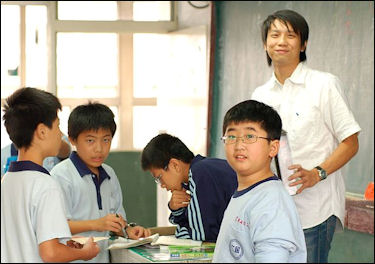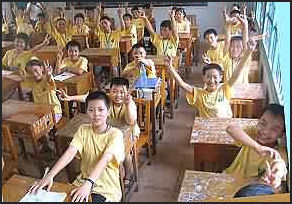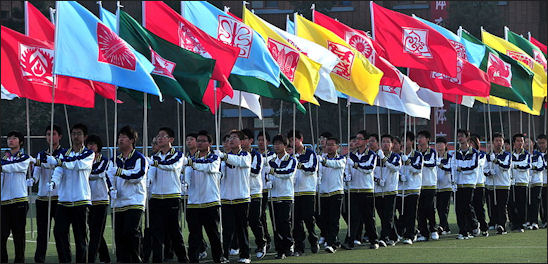PRIMARY EDUCATION IN CHINA

The education system provides free primary education for five years (six if you include kindergarten). Children enter the first grade of primary school at the age of 6 or 7. . Primary education includes six-year programs and five-year programs. There are three types of schools: full-time elementary, rural elementary, and simple elementary (Ashmore & Cao 1997). [Source: Ting Ni, World Education Encyclopedia, Gale Group Inc., 2001]
Gross enrollment primary: 100 percent (2019). In 2001, about 94 percent of age-eligible children were enrolled in primary school. The student-teacher ratio in primary school at that time was about 21 to 1. [Sources: World Bank datatopics.worldbank.org; Junior Worldmark Encyclopedia of the Nations, Thomson Gale, 2007]
The United Nations Development Programme reported that in 2003 China had 116,390 kindergartens with 613,000 teachers and 20 million students. At that time, there were 425,846 primary schools with 5.7 million teachers and 116.8 million students. [Source: Library of Congress, August 2006]
Primary Schools in 1999: 628,840
Primary Educational Enrollment: 139,954,000
Educational Enrollment Rate: 123 percent
Teachers: 5,794,000
[Source: China Statistical Yearbook 1999]
In 2014, New York Times columnist Thomas L. Friedman visited Shanghai’s Qiangwei Primary School, with 754 students — grades one through five — and 59 teachers. He wrote: “When you sit in on a class here and meet with the principal and teachers, what you find is a relentless focus on all the basics that we know make for high-performing schools but that are difficult to pull off consistently across an entire school system. These are: a deep commitment to teacher training, peer-to-peer learning and constant professional development, a deep involvement of parents in their children’s learning, an insistence by the school’s leadership on the highest standards and a culture that prizes education and respects teachers. [Source:Thomas L. Friedman, New York Times, October 22, 2013]
See Separate Articles:CHINESE SCHOOLS Factsanddetails.com/China ; EDUCATION IN CHINA: STATISTICS, LITERACY, WOMEN AND TEST SCORE SUCCESSES Factsanddetails.com/China ; CHINESE EDUCATION SYSTEM: LAWS, REFORMS, COSTS factsanddetails.com ; CHILD REARING IN CHINA factsanddetails.com ; LITTLE EMPERORS AND MIDDLE CLASS KIDS IN CHINA factsanddetails.com ; SCHOOL LIFE IN CHINA: RULES, REPORT CARDS, FILES, CLASSES Factsanddetails.com/China ; VILLAGE SCHOOLS IN 19TH CENTURY CHINA factsanddetails.com ; SCHOOL CURRICULUM IN CHINA factsanddetails.com ; PROBLEMS AT CHINESE SCHOOLS: CHEATING, EXPLOSIONS AND MYOPIA factsanddetails.com ; TEACHERS IN CHINA factsanddetails.com ; PRESCHOOLS AND KINDERGARTEN IN CHINA factsanddetails.com ; SECONDARY SCHOOLS IN CHINA factsanddetails.com THE
RECOMMENDED BOOKS: School Life” “Studying in China: A Practical Handbook for Students” by Patrick McAloon Amazon.com; “Other Rivers: A Chinese Education” by Peter Hessler Amazon.com; “Educating Young Giants: What Kids Learn (And Don’t Learn) in China and America” by N. Pine (2012) Amazon.com; Little Soldiers: An American Boy, a Chinese School, and the Global Race to Achieve by Lenora Chu, Emily Woo Zeller, et al. Amazon.com; “No School Left Behind” by Wei Gao and Xianwei Liu (2023) Amazon.com ; Preschool: “Preschool in Three Cultures Revisited: China, Japan, and the United States” by Joseph Tobin, Yeh Hsueh, et al. Amazon.com; “Embracing the New Two-Child Policy Era: Challenge and Countermeasures of Early Care and Education in China”by Xiumin Hong, Wenting Zhu, et al. (2022) Amazon.com; Cram Schools: “The Fruits of Opportunism: Noncompliance and the Evolution of China's Supplemental Education Industry” by Le Lin Amazon.com; “Demand for Private Supplementary Tutoring in China: Parents' Decision-Making” by Junyan Liu Amazon.com
Primary School Education in China
The development of primary education in so vast a country as China was a formidable accomplishment. In contrast to the 20- percent enrollment rate before 1949, in 1985 about 96 percent of primary-school-age children were enrolled in approximately 832,300 primary schools. This enrollment figure compared favorably with the record figures of the late 1960s and early 1970s, when enrollment standards were more egalitarian. [Source: Library of Congress*]
The most important document regarding primary education policy was The Government Administration Council Directive Concerning the Reorganization and Improvement of Primary School Education signed by Premier Zhou Enlai in 1953. It required primary schools throughout China to have the same pedagogical plan and to develop the same systems of governing attendance, leave, and certification of attainment. [Source: Ting Ni, World Education Encyclopedia, Gale Group Inc., 2001]

Elementary school class
“Under the Law on Nine-Year Compulsory Education passed in the 1980s, primary schools were to be tuition-free and reasonably located for the convenience of children attending them; students would attend primary schools in their neighborhoods or villages. Parents paid a small fee per term for books and other expenses such as transportation, food, and heating. Previously, fees were not considered a deterrent to attendance, although some parents felt even these minor costs were more than they could afford. Under the education reform, students from poor families received stipends, and state enterprises, institutions, and other sectors of society were encouraged to establish their own schools. *
Children usually entered primary school at seven years of age for six days a week. The two-semester school year consisted of 9.5 months, with a long vacation in July and August. Urban primary schools typically divided the school week into twenty-four to twenty-seven classes of forty-five minutes each, but in the rural areas the norm was half-day schooling, more flexible schedules, and itinerant teachers. Most primary schools had a five-year course, except in such cities as Beijing and Shanghai, which had reintroduced six-year primary schools and accepted children at six and one-half years rather than seven.
Rural Primary Schools in China
“Two programs were developed to satisfy the need for education in less developed areas. One is the half-and-half agricultural secondary school. Students in this kind of school spend a half-day in study and a half-day in labor to support themselves. Their facilities are often primitive: a hastily erected shack or the floor of a barn.
Another program is the part-time primary school, often called "simplified primary school." It usually offers a few daily classes taught by locally recruited teachers, usually themselves only primary school graduates. The classrooms are often located in old temples and the facilities are ill-suited for students. These are known as minban (popularly-run) schools, which are run communally by villages; they are solely supported by village funds and do not receive any financial support from the national government.
Minban schools do not intend to prepare students for further education or for vocations different from those of their parents. The number of minban schools is unreported by Chinese authorities. Theoretically, every primary school teacher should be paid by the government. In reality, sometimes it is hard to find a teacher in rural areas. Villagers need to recruit teachers themselves, and the salary of the teacher is drawn from village funds.
Elementary School Classes
A typical class has a Class Monitor, Homework Monitor, Hygiene Monitor and Politeness Monitor. Among the duties of the Politeness Monitor are reporting on students that have gotten into fights and said bad words. The elections for these junior cadres positions is serious stuff. Typically every students run for something. The campaigns are like self-criticism sessions with the candidates admitting flaws and vowing to improve them, and then asking for votes. [Source: Peter Hessler, The New Yorker, March 31, 2008]
Ting Ni wrote in the World Education Encyclopedia: “Primary classes are large, the atmosphere is formal, and discipline is quite strict. Children are no longer required to sit with their hands clasped behind their backs as they were before the Cultural Revolution (1966-1976), but they sit in straight rows, stand up to answer the teacher, and recite much of what they are required to learn in unison. [Source: Ting Ni, World Education Encyclopedia, Gale Group Inc., 2001]
Fifth grade in elementary school is particularly tough. Many students take their regular classes plus preps classes for the entrance exam to middle schools. Students are given backs tests with their class ranking on the test. Those that lag behind are often punished. In gym class the slowest person in each group in running races has to do an extra lap.
Many kids take entrance exam to get into good middle school. If you don’t get in a top middle school, your chances of getting into a good high school are diminished, which hurts your chances of getting into a good college.
Primary School Curriculum
The primary-school curriculum consisted of Chinese, mathematics, physical education, music, drawing, and elementary instruction in nature, history, and geography, combined with practical work experiences around the school compound. A general knowledge of politics and moral training, which stressed love of the motherland, love of the party, and love of the people (and previously love of Chairman Mao), was another part of the curriculum. A foreign language, often English, was introduced in about the third grade. Chinese and mathematics accounted for about 60 percent of the scheduled class time; natural science and social science accounted for about 8 percent. Putonghua (common spoken language) was taught in regular schools and pinyin romanization in lower grades and kindergarten. [Source: Library of Congress]
“The State Education Commission required that all primary schools offer courses on communist ideology and morality. Beginning in the fourth grade, students usually had to perform productive labor two weeks per semester to relate classwork with production experience in workshops or on farms and subordinate it to academic study. Most schools had after-hour activities at least one day per week--often organized by the Young Pioneers--to involve students in recreation and community service.
Ting Ni wrote in the World Education Encyclopedia: “The curriculum for primary schools is very much standardized in China. There are standard textbooks for curricula at all levels. The central theme of these uniformly written textbooks is that China is a unified, glorious country with a great past and a bright future. Despite considerable variation in geography, agriculture, climate, language, and local customs, nearly the same subjects are taught with the same materials throughout the country. The standardized curriculum dictates that 40 percent of class hours should be devoted to the study of Chinese (including reading, writing, composition, and speaking). A further 24 percent of class hours is devoted to arithmetic. The remaining class hours are absorbed by physical education, music, art, natural science, politics, geography, and history. Increasingly, foreign languages, particularly English, have become optional courses. The government planned to make English a mandatory course starting at the third year of primary school at the beginning of the twenty-first century. [Source: Ting Ni, World Education Encyclopedia, Gale Group Inc., 2001]

sports meet
First Grader’s 'Wrong' Answer Trigger Weibo Morality Debate
In April 2012, the Ministry of Tofu reported: “In a quiz on Chinese reading, a first grader answered “No, I won’t to the question “Would you give up your pear out of courtesy to your brothers if you were Kong Rong?” He got a huge “X” for his answer from his teacher. The child’s father, upon seeing the answer sheet, took a picture of it and uploaded it to Sina Weibo, the hugely popular microblogging service, which has had the nation question the purpose of education. [Source: Ministry of Tofu, April 19, 2012]
The reading section of the exam is a passage, written in both Chinese characters and pinyin, about a classic moral story, commonly known as “Kong Rong giving up pears”, that has been taught in elementary schools since the Song Dynasty in the same way the tale of George Washington felling a cherry tree lingers in the U.S. classes. According to the story, Kong Rong, later a politician in late Han Dynasty, picked the smallest of all pears and let his brothers choose the rest that were bigger, despite being only 4-year-old and the youngest in the family at the time.
“The post by the child’s father was reposted by 2,000 users and received 400 comments within one day. It is heatedly discussed on Sina Weibo, as netizens debate if educators should enforce values onto students, and if honest expression of unorthodox opinion should be encouraged. A reporter from Dongfang Daily contacted the child’s father. The child is in Grade 1 at an elementary school in the city of Shanghai.
“When the father saw the exam paper, he questioned his son about the answer, but the son insisted that he was not being playful.” I asked him, “Why did you write that you won’t give up your pear?” He answered, “I don’t think Kong Rong, a 4-year-old, would have actually done that.” I asked him why not. He answered, “Because he was only 4 years old,” the father recalled. He said that his son was pretty confident in the answer and refused to correct it, at least not until he got an explanation from the teacher.”Actually, my son is not selfish. He understands the significance of sharing. He passes food to me, his mother and his grandma at the table every day.” The majority of the flurry of the online commentary it inspires is supportive of the little boy. In an online survey on Sina Weibo, 57.1 percent of all 3,569 respondents say they wouldn’t give up pears in Kong Rong’s situation, and 23.7 percent say “I don’t know.”
Image Sources: Wiki Commons: Nolls China website ; ; Columbia University; Beifan.com ; University of Washington; Bucklin archives
Text Sources: New York Times, Washington Post, Los Angeles Times, Times of London, National Geographic, The New Yorker, Time, Newsweek, Reuters, AP, Lonely Planet Guides, Compton’s Encyclopedia and various books and other publications.
Last updated August 2022
